Abstract
We have studied the effects of single oral doses of, and of 28 days treatment with, placebo, propranolol or metoprolol, on the metabolic and hormonal responses to prolonged exercise in hypertensive men. Blood glucose levels fell during exercise on all occasions. No additional effects of the beta-adrenoceptor antagonists, compared to placebo, were observed. The exercise-induced increase in plasma potassium was enhanced after a single dose of propranolol or metoprolol, and also after chronic treatment with propranolol. Chronic treatment with either drug led to an increase in plasma potassium levels at rest. The growth hormone response to exercise was potentiated by a single dose of metoprolol or propranolol, and after chronic treatment with the drugs. A single dose of propranolol (but not metoprolol) was associated with a marked increase in plasma cortisol and adrenaline levels during exercise. After chronic treatment no such increase occurred. In both the acute and chronic phases of the study, blood lactate levels were higher during exercise in the presence of either propranolol or metoprolol compared to placebo, whereas non-esterified fatty acid levels were lower. A single dose of metoprolol produced a significantly greater reduction in blood glycerol levels during exercise than a single dose of propranolol. After chronic treatment, both propranolol and metoprolol produced similar reductions in blood glycerol levels during exercise. After a single dose, both drugs significantly augmented the increase in plasma noradrenaline levels during exercise. A similar effect was seen after chronic treatment.
Full text
PDF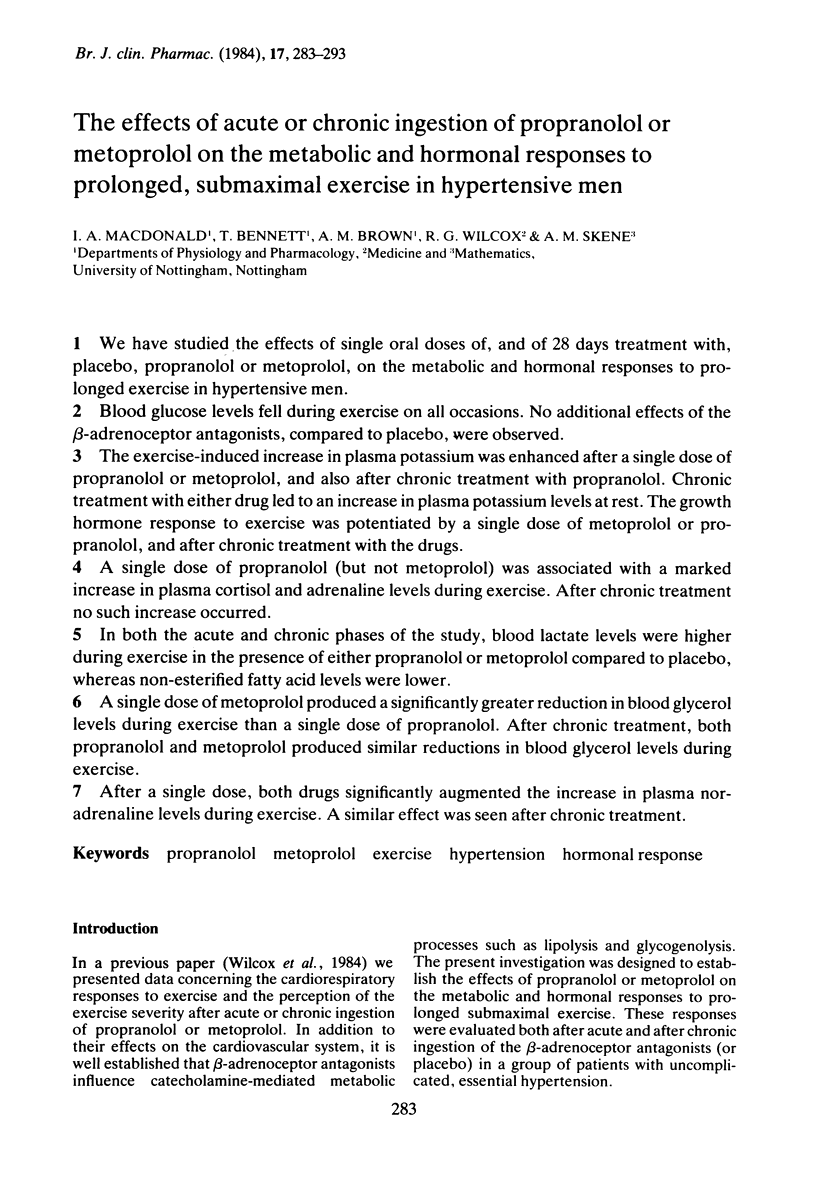

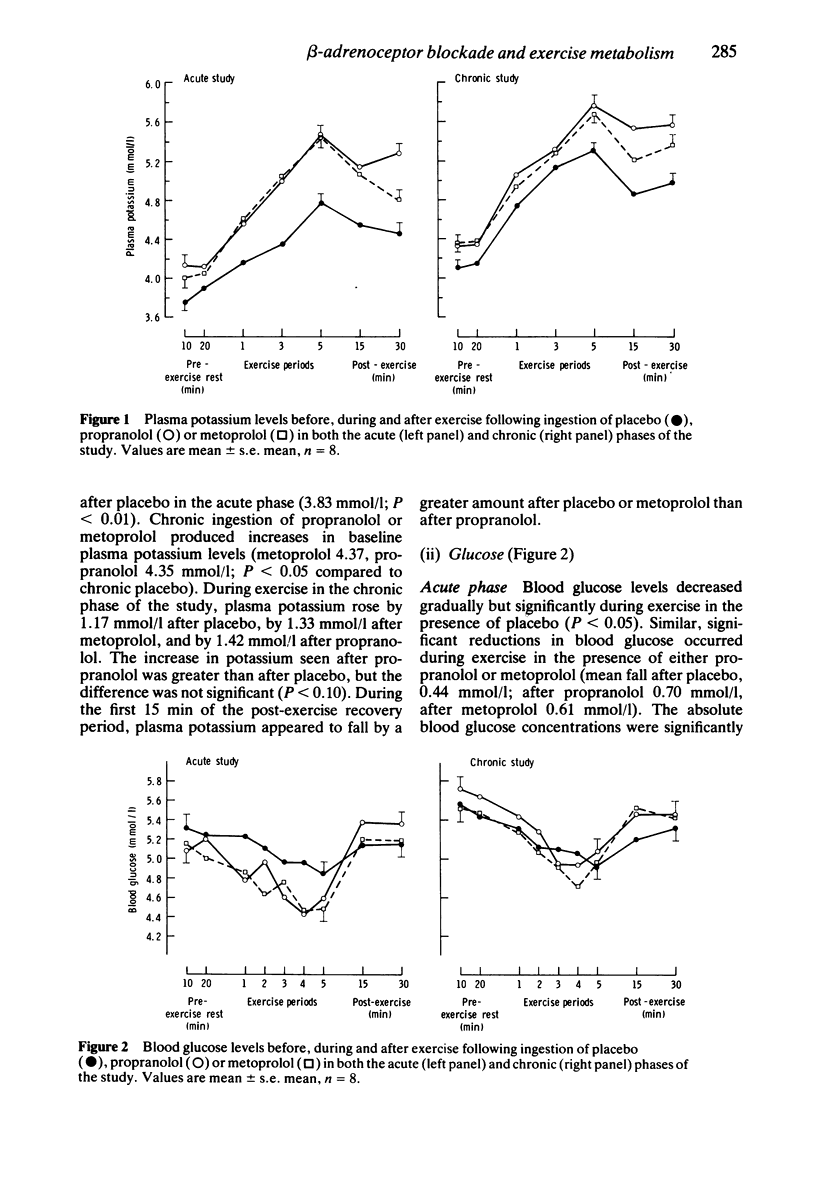
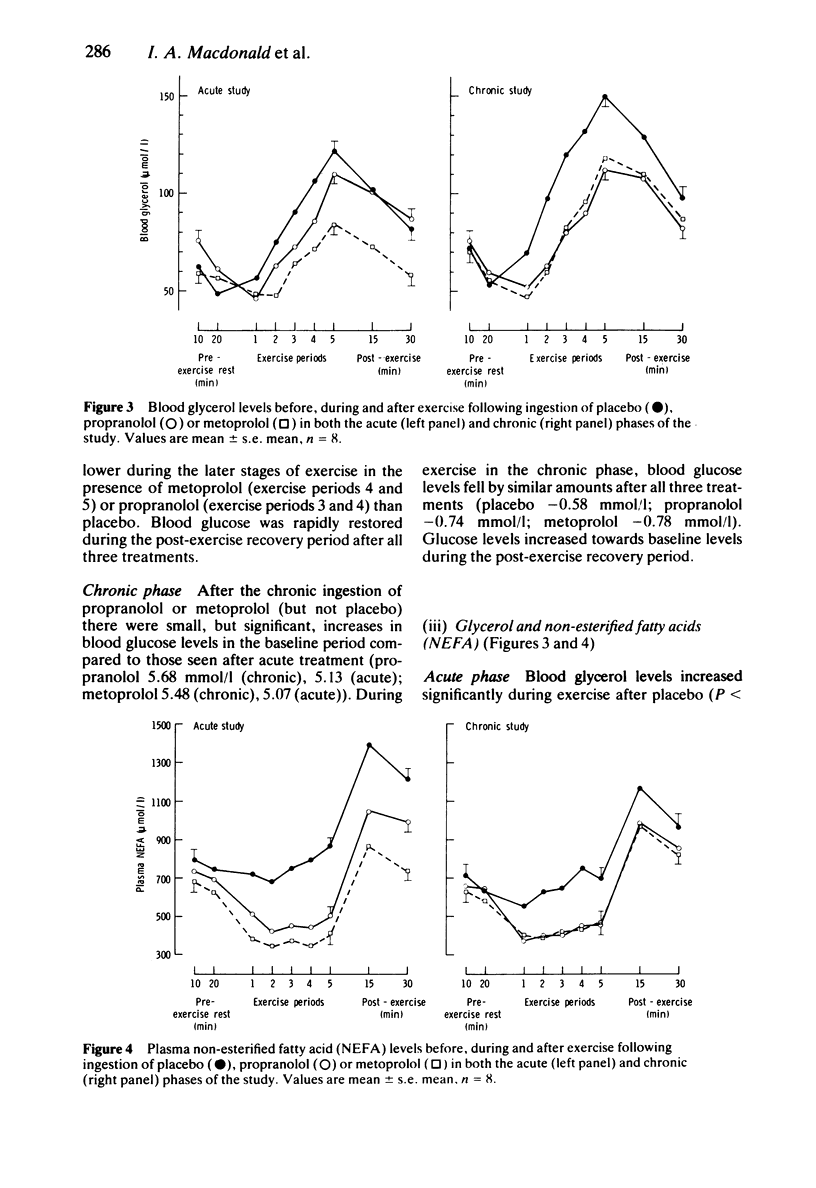
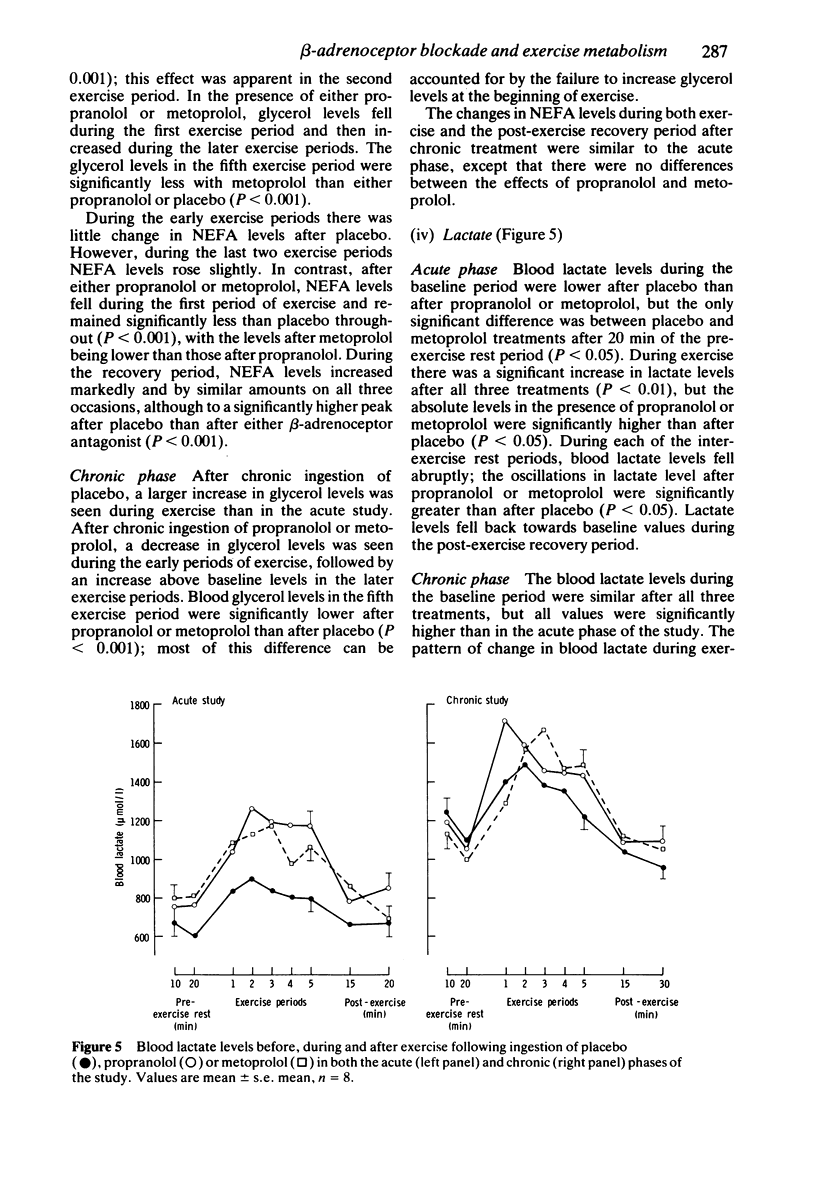

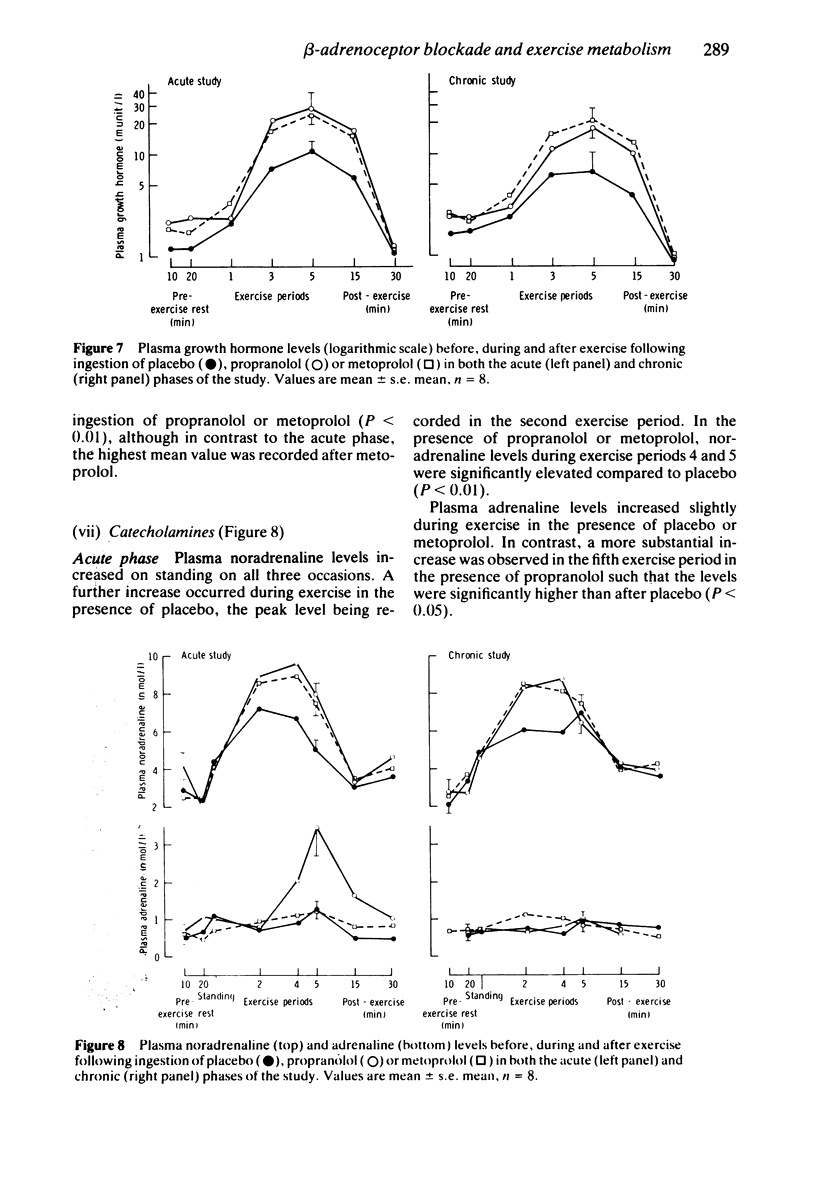
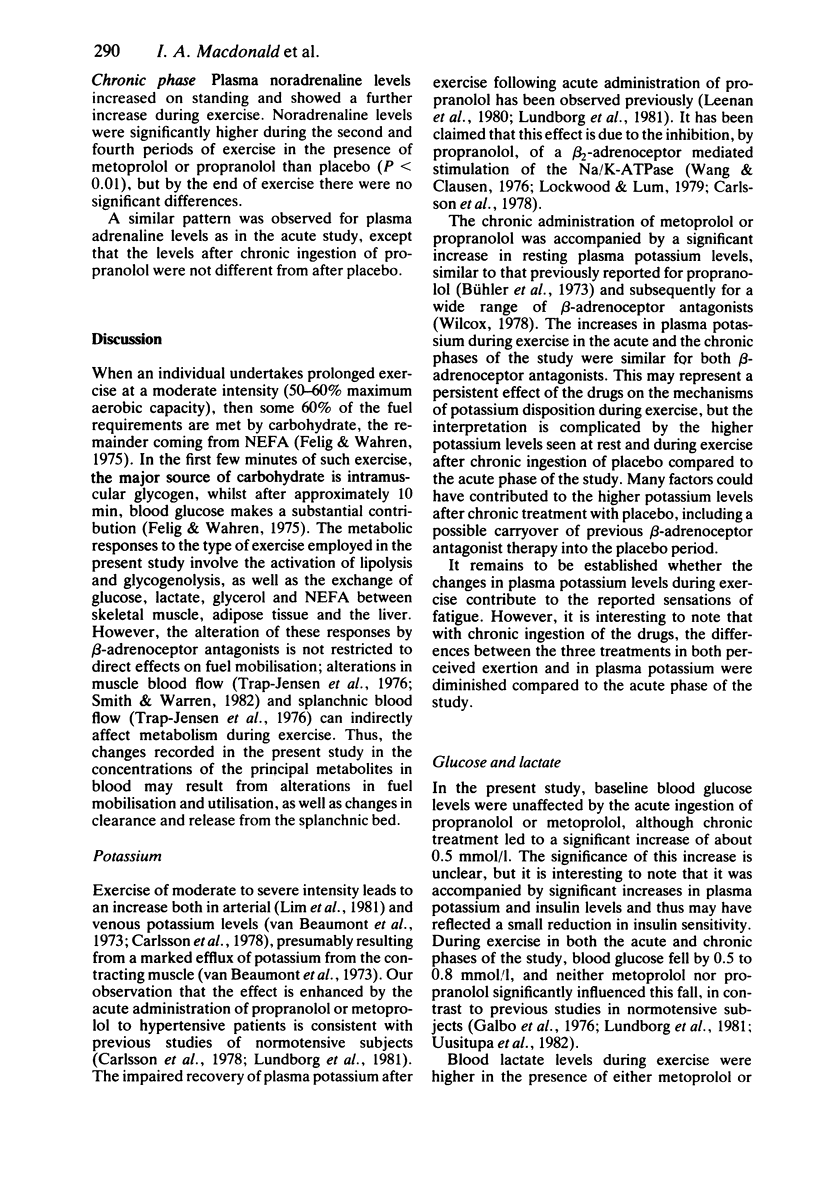


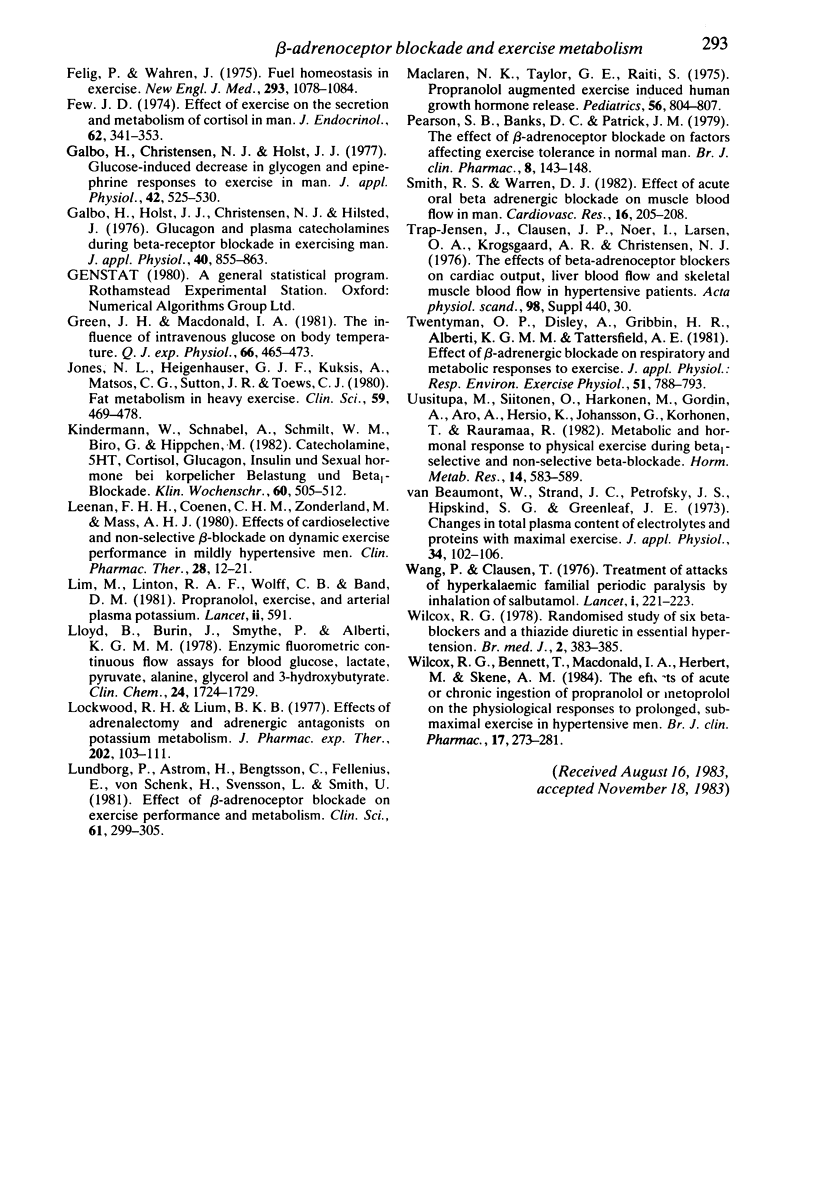
Selected References
These references are in PubMed. This may not be the complete list of references from this article.
- Best J. D., Halter J. B. Release and clearance rates of epinephrine in man: importance of arterial measurements. J Clin Endocrinol Metab. 1982 Aug;55(2):263–268. doi: 10.1210/jcem-55-2-263. [DOI] [PubMed] [Google Scholar]
- Bühler F. R., Laragh J. H., Vaughan E. D., Jr, Brunner H. R., Gavras H., Baer L. Antihypertensive action of propranolol. Specific antirenin responses in high and normal renin forms of essential, renal, renovascular and malignant hypertension. Am J Cardiol. 1973 Sep 20;32(4):511–522. doi: 10.1016/s0002-9149(73)80043-8. [DOI] [PubMed] [Google Scholar]
- Carlsson E., Fellenius E., Lundborg P., Svensson L. beta-Adrenoceptor blockers, plasma-potassium, and exercise. Lancet. 1978 Aug 19;2(8086):424–425. doi: 10.1016/s0140-6736(78)91893-7. [DOI] [PubMed] [Google Scholar]
- Clutter W. E., Bier D. M., Shah S. D., Cryer P. E. Epinephrine plasma metabolic clearance rates and physiologic thresholds for metabolic and hemodynamic actions in man. J Clin Invest. 1980 Jul;66(1):94–101. doi: 10.1172/JCI109840. [DOI] [PMC free article] [PubMed] [Google Scholar]
- Critchley J. A., Ellis P., Henderson C. G., Ungar A. The role of the pituitary-adrenocortical axis in reflex responses of the adrenal medulla of the dog. J Physiol. 1982 Feb;323:533–541. doi: 10.1113/jphysiol.1982.sp014090. [DOI] [PMC free article] [PubMed] [Google Scholar]
- Cryer P. E., Rizza R. A., Haymond M. W., Gerich J. E. Epinephrine and norepinephrine are cleared through beta-adrenergic, but not alpha-adrenergic, mechanisms in man. Metabolism. 1980 Nov;29(11 Suppl 1):1114–1118. doi: 10.1016/0026-0495(80)90019-0. [DOI] [PubMed] [Google Scholar]
- Dorow P. Effects of beta-adrenoceptor blockade on carbohydrate metabolism during exercise--comparison of pindolol and metoprolol. Br J Clin Pharmacol. 1982;13(Suppl 2):429S–430S. doi: 10.1111/j.1365-2125.1982.tb01951.x. [DOI] [PMC free article] [PubMed] [Google Scholar]
- Elphick M. C. Automated modification of Duncombe's method for the ultramicro determination of serum free fatty acids. J Lipid Res. 1975 Sep;16(5):402–406. [PubMed] [Google Scholar]
- Felig P., Wahren J. Fuel homeostasis in exercise. N Engl J Med. 1975 Nov 20;293(21):1078–1084. doi: 10.1056/NEJM197511202932107. [DOI] [PubMed] [Google Scholar]
- Few J. D. Effect of exercise on the secretion and metabolism of cortisol in man. J Endocrinol. 1974 Aug;62(2):341–353. [PubMed] [Google Scholar]
- Galbo H., Christensen N. J., Holst J. J. Glucose-induced decrease in glucagon and pinephrine responses to exercise in man. J Appl Physiol Respir Environ Exerc Physiol. 1977 Apr;42(4):525–530. doi: 10.1152/jappl.1977.42.4.525. [DOI] [PubMed] [Google Scholar]
- Galbo H., Holst J. J., Christensen N. J., Hilsted J. Glucagon and plasma catecholamines during beta-receptor blockade in exercising man. J Appl Physiol. 1976 Jun;40(6):855–863. doi: 10.1152/jappl.1976.40.6.855. [DOI] [PubMed] [Google Scholar]
- Green J. H., Macdonald I. A. The influence of intravenous glucose on body temperature. Q J Exp Physiol. 1981 Oct;66(4):465–473. doi: 10.1113/expphysiol.1981.sp002588. [DOI] [PubMed] [Google Scholar]
- Jones N. L., Heigenhauser G. J., Kuksis A., Matsos C. G., Sutton J. R., Toews C. J. Fat metabolism in heavy exercise. Clin Sci (Lond) 1980 Dec;59(6):469–478. doi: 10.1042/cs0590469. [DOI] [PubMed] [Google Scholar]
- Kindermann W., Schnabel A., Schmitt W. M., Biro G., Hippchen M. Catecholamine, STH, Cortisol, Glucagon, Insulin und Sexualhormone bei körperlicher Belastung und Beta 1-Blockade. Klin Wochenschr. 1982 May 17;60(10):505–512. doi: 10.1007/BF01756096. [DOI] [PubMed] [Google Scholar]
- Leenen F. H., Coenen C. H., Zonderland M., Maas A. H. Effects of cardioselective and nonselective beta-blockade on dynamic exercise performance in mildly hypertensive men. Clin Pharmacol Ther. 1980 Jul;28(1):12–21. doi: 10.1038/clpt.1980.124. [DOI] [PubMed] [Google Scholar]
- Lim M., Linton R. A., Wolff C. B., Band D. M. Propranolol, exercise, and arterial plasma potassium. Lancet. 1981 Sep 12;2(8246):591–591. doi: 10.1016/s0140-6736(81)90987-9. [DOI] [PubMed] [Google Scholar]
- Lloyd B., Burrin J., Smythe P., Alberti K. G. Enzymic fluorometric continuous-flow assays for blood glucose, lactate, pyruvate, alanine, glycerol, and 3-hydroxybutyrate. Clin Chem. 1978 Oct;24(10):1724–1729. [PubMed] [Google Scholar]
- Lockwood R. H., Lum B. K. Effects of adrenalectomy and adrenergic antagonists on potassium metabolism. J Pharmacol Exp Ther. 1977 Oct;203(1):103–111. [PubMed] [Google Scholar]
- Lundborg P., Aström H., Bengtsson C., Fellenius E., von Schenck H., Svensson L., Smith U. Effect of beta-adrenoceptor blockade on exercise performance and metabolism. Clin Sci (Lond) 1981 Sep;61(3):299–305. doi: 10.1042/cs0610299. [DOI] [PubMed] [Google Scholar]
- Maclaren N. K., Taylor G. E., Raiti S. Propranolol-augmented, exercise-induced human growth hormone release. Pediatrics. 1975 Nov;56(5):804–807. [PubMed] [Google Scholar]
- Pearson S. B., Banks D. C., Patrick J. M. The effect of beta-adrenoceptor blockade on factors affecting exercise tolerance in normal man. Br J Clin Pharmacol. 1979 Aug;8(2):143–148. doi: 10.1111/j.1365-2125.1979.tb05812.x. [DOI] [PMC free article] [PubMed] [Google Scholar]
- Smith R. S., Warren D. J. Effect of acute oral beta adrenergic blockade on muscle blood flow in man. Cardiovasc Res. 1982 Apr;16(4):205–208. doi: 10.1093/cvr/16.4.205. [DOI] [PubMed] [Google Scholar]
- Twentyman O. P., Disley A., Gribbin H. R., Alberti K. G., Tattersfield A. E. Effect of beta-adrenergic blockade on respiratory and metabolic responses to exercise. J Appl Physiol Respir Environ Exerc Physiol. 1981 Oct;51(4):788–793. doi: 10.1152/jappl.1981.51.4.788. [DOI] [PubMed] [Google Scholar]
- Uusitupa M., Siitonen O., Härkönen M., Gordin A., Aro A., Hersio K., Johansson G., Korhonen T., Rauramaa R. Metabolic and hormonal response to physical exercise during beta 1-selective and non-selective beta-blockade. Horm Metab Res. 1982 Nov;14(11):583–588. doi: 10.1055/s-2007-1019087. [DOI] [PubMed] [Google Scholar]
- Wang P., Clausen T. Treatment of attacks in hyperkalaemic familial periodic paralysis by inhalation of salbutamol. Lancet. 1976 Jan 31;1(7953):221–223. doi: 10.1016/s0140-6736(76)91340-4. [DOI] [PubMed] [Google Scholar]
- Wilcox R. G., Bennett T., Macdonald I. A., Herbert M., Skene A. M. The effects of acute or chronic ingestion of propranolol or metoprolol on the physiological responses to prolonged, submaximal exercise in hypertensive men. Br J Clin Pharmacol. 1984 Mar;17(3):273–281. doi: 10.1111/j.1365-2125.1984.tb02342.x. [DOI] [PMC free article] [PubMed] [Google Scholar]
- Wilcox R. G. Randomised study of six beta-blockers and a thiazide diuretic in essential hypertension. Br Med J. 1978 Aug 5;2(6134):383–385. doi: 10.1136/bmj.2.6134.383. [DOI] [PMC free article] [PubMed] [Google Scholar]
- van Beaumont W., Strand J. C., Petrofsky J. S., Hipskind S. G., Greenleaf J. E. Changes in total plasma content of electrolytes and proteins with maximal exercise. J Appl Physiol. 1973 Jan;34(1):102–106. doi: 10.1152/jappl.1973.34.1.102. [DOI] [PubMed] [Google Scholar]


